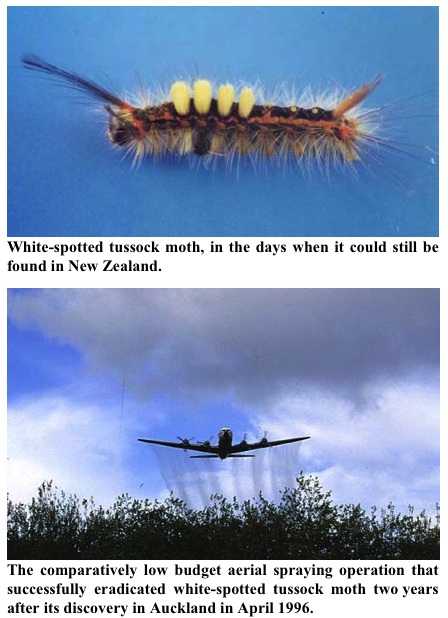PESTS AND DISEASES OF FORESTRY IN NEW ZEALAND
White-spotted tussock response - how good was it?
Scion is the leading provider of forest-related knowledge in New Zealand
Formerly known as the Forest Research Institute, Scion has been a leader in research relating to forest health for over 50 years. The Rotorua-based Crown Research Institute continues to provide science that will protect all forests from damage caused by insect pests, pathogens and weeds. The information presented below arises from these research activities.
From Forest Health News 127, March 2003.
 A full account of the eradication programme for white-spotted tussock moth was recently published and is now available in the public domain*. Subsequent to this, Forest Research’s Forest Health Group has just released a review of the programme, in order to compare the actual response with currently accepted “best practice”. This report draws on the extensive documentation that accumulated during the campaign, together with the personal experience of those involved. The six stages making up the programme, detection, evaluation, response, decision-making, operations, and monitoring and review, are broken down into their components, and each section is rated out of 10.
A full account of the eradication programme for white-spotted tussock moth was recently published and is now available in the public domain*. Subsequent to this, Forest Research’s Forest Health Group has just released a review of the programme, in order to compare the actual response with currently accepted “best practice”. This report draws on the extensive documentation that accumulated during the campaign, together with the personal experience of those involved. The six stages making up the programme, detection, evaluation, response, decision-making, operations, and monitoring and review, are broken down into their components, and each section is rated out of 10.
The review also summarises the lessons learnt, in order to enable an even better incursion response in the future. The work was funded as part of the Forest Health and Biosecurity FRST programme and the report is available both electronically and in hard copy by contacting Rose O’Brien (rose.obrien@forestresearch.co.nz).
Gordon Hosking, Forest Research
* Hosking, G.; Clearwater, J.; Handiside, J., Kay, M., Ray, J., and Simmons, N. (2003): Tussock moth eradication – a success story from New Zealand. International Journal of Pest Management 49 (1): 17-24 (Jan.-March 2003).
This information is intended for general interest only. It is not intended to be a substitute for specific specialist advice on any matter and should not be relied on for that purpose. Scion will not be liable for any direct, indirect, incidental, special, consequential or exemplary damages, loss of profits, or any other intangible losses that result from using the information provided on this site.
(Scion is the trading name of the New Zealand Forest Research Institute Limited.)

 Farm Forestry New Zealand
Farm Forestry New Zealand

